最新初中英语8种时态讲解及练习
- 格式:doc
- 大小:117.00 KB
- 文档页数:12
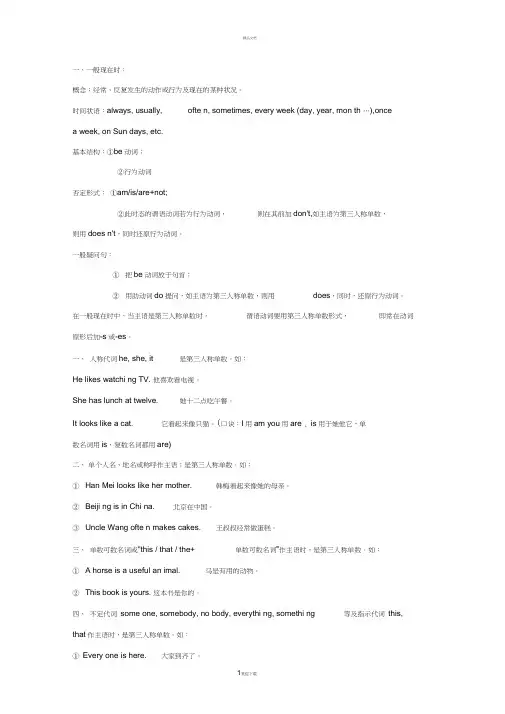
一、一般现在时:概念:经常、反复发生的动作或行为及现在的某种状况。
时间状语:always, usually, ofte n, sometimes, every week (day, year, mon th …),oncea week, on Sun days, etc.基本结构:①be动词;②行为动词否定形式:①am/is/are+not;②此时态的谓语动词若为行为动词,则在其前加don't,如主语为第三人称单数,则用does n't,同时还原行为动词。
一般疑问句:①把be动词放于句首;②用助动词do提问,如主语为第三人称单数,则用does,同时,还原行为动词。
在一般现在时中,当主语是第三人称单数时,谓语动词要用第三人称单数形式,即常在动词原形后加-s或-es。
一、人称代词he, she, it 是第三人称单数。
如:He likes watchi ng TV. 他喜欢看电视。
She has lunch at twelve. 她十二点吃午餐。
It looks like a cat. 它看起来像只猫。
(口诀:I用am you用are , is用于她他它,单数名词用is,复数名词都用are)二、单个人名、地名或称呼作主语;是第三人称单数。
如:①Han Mei looks like her mother. 韩梅看起来像她的母亲。
②Beiji ng is in Chi na. 北京在中国。
③Uncle Wang ofte n makes cakes. 王叔叔经常做蛋糕。
三、单数可数名词或"this / that / the+ 单数可数名词”作主语时,是第三人称单数。
如:① A horse is a useful an imal. 马是有用的动物。
②This book is yours. 这本书是你的。
四、不定代词some one, somebody, no body, everythi ng, somethi ng 等及指示代词this, that作主语时,是第三人称单数。
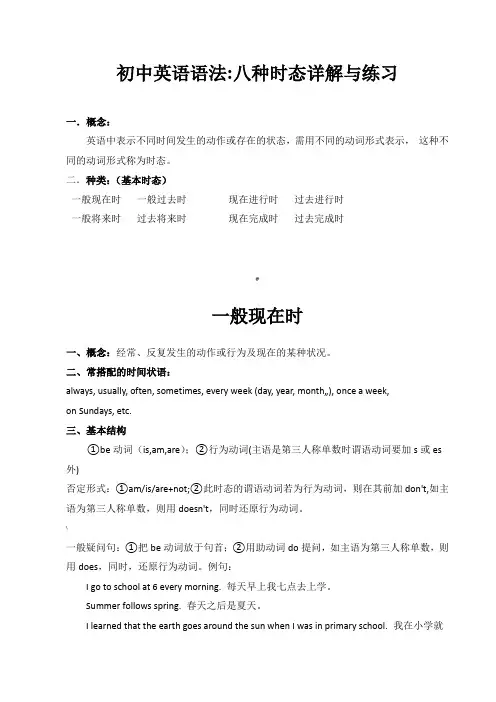
初中英语语法:八种时态详解与练习一.概念:英语中表示不同时间发生的动作或存在的状态,需用不同的动词形式表示,这种不同的动词形式称为时态。
二.种类:(基本时态)一般现在时一般过去时现在进行时过去进行时一般将来时过去将来时现在完成时过去完成时@一般现在时一、概念:经常、反复发生的动作或行为及现在的某种状况。
二、常搭配的时间状语:always, usually, often, sometimes, every we ek (day, year, month…), once a week,on Sundays, etc.三、基本结构①be动词(is,am,are);②行为动词(主语是第三人称单数时谓语动词要加s或es 外)否定形式:①am/is/are+not;②此时态的谓语动词若为行为动词,则在其前加don't,如主语为第三人称单数,则用doesn't,同时还原行为动词。
\一般疑问句:①把be动词放于句首;②用助动词do提问,如主语为第三人称单数,则用does,同时,还原行为动词。
例句:I go to school at 6 every morning. 每天早上我七点去上学。
Summer follows spring. 春天之后是夏天。
I learned that the earth goes around the sun when I was in primary school. 我在小学就学过地球是围绕太阳转的。
Pride goes before a fall. 骄者必败。
四、基本用法:1) 描述当前时间内经常出现、反复发生的动作或存在的状态。
在这种情景中,句子常带有表示频率的时间状语:always , everyday , often , once a week (month , year , etc.) , sometimes , seldom , usually等等,以表示句中的动作或状态是习惯性的、经常性的。
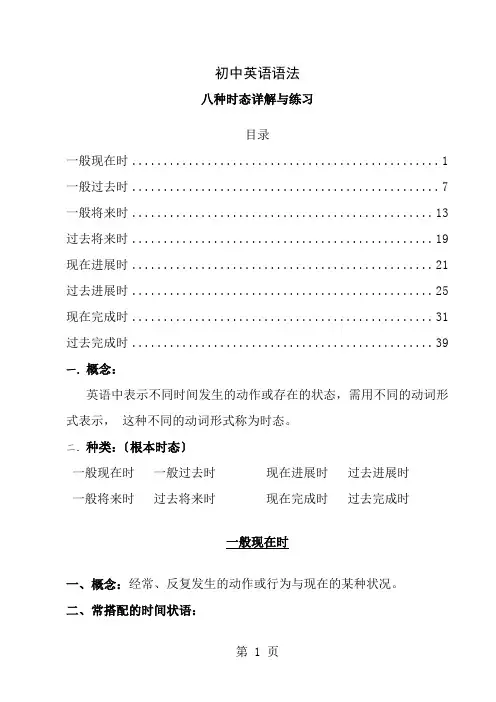
第 1 页 初中英语语法 八种时态详解与练习
目录 一般现在时 ................................................. 1 一般过去时 ................................................. 7 一般将来时 ................................................ 13 过去将来时 ................................................ 19 现在进展时 ................................................ 21 过去进展时 ................................................ 25 现在完成时 ................................................ 31 过去完成时 ................................................ 39 一.概念: 英语中表示不同时间发生的动作或存在的状态,需用不同的动词形式表示, 这种不同的动词形式称为时态。 二.种类:〔根本时态〕 一般现在时 一般过去时 现在进展时 过去进展时 一般将来时 过去将来时 现在完成时 过去完成时
一般现在时 一、概念:经常、反复发生的动作或行为与现在的某种状况。 二、常搭配的时间状语: 第 2 页
always, usually, often, sometimes, every week (day, year, month„), once a week, on Sundays, etc. 三、根本构造 ①be动词〔is,am,are〕;②行为动词(主语是第三人称单数时谓语动词要加s或es外) 否认形式:①am/is/are+not;②此时态的谓语动词假设为行为动词,那么在其前加don't,如主语为第三人称单数,那么用doesn't,同时复原行为动词。 一般疑问句:①把be动词放于句首;②用助动词do提问,如主语为第三人称单数,那么用does,同时,复原行为动词。例句: I go to school at 6 every morning. 每天早上我七点去上学。 Summer follows spring. 春天之后是夏天。 I learned that the earth goes around the sun when I was in primary school. 我在小学就学过地球是围绕太阳转的。 Pride goes before a fall. 骄者必败。 四、根本用法: 1) 描述当前时间内经常出现、反复发生的动作或存在的状态。 在这种情景中,句子常带有表示频率的时间状语:always , everyday , often , once a week (month , year , etc.) , sometimes , seldom , usually等等,以表示句中的动作或状态是习惯性的、经常性的。例如: 第 3 页
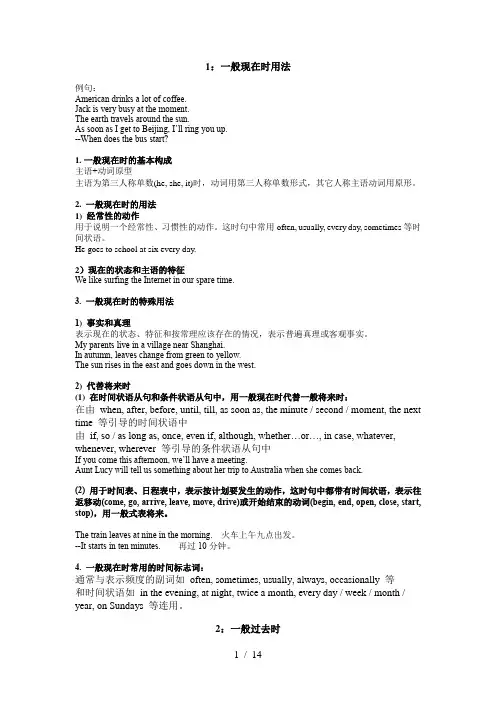
1:一般现在时用法例句:American drinks a lot of coffee.Jack is very busy at the moment.The earth travels around the sun.As soon as I get to Beijing, I’ll ring you up.--When does the bus start?1.一般现在时的基本构成主语+动词原型主语为第三人称单数(he, she, it)时,动词用第三人称单数形式,其它人称主语动词用原形。
2. 一般现在时的用法1) 经常性的动作用于说明一个经常性、习惯性的动作。
这时句中常用often, usually, every day, sometimes等时间状语。
He goes to school at six every day.2)现在的状态和主语的特征We like surfing the Internet in our spare time.3. 一般现在时的特殊用法1) 事实和真理表示现在的状态、特征和按常理应该存在的情况,表示普遍真理或客观事实。
My parents live in a village near Shanghai.In autumn, leaves change from green to yellow.The sun rises in the east and goes down in the west.2) 代替将来时(1) 在时间状语从句和条件状语从句中,用一般现在时代替一般将来时:在由when, after, before, until, till, as soon as, the minute / second / moment, the next time 等引导的时间状语中由if, so / as long as, once, even if, although, whether…or…, in case, whatever, whenever, wherever 等引导的条件状语从句中If you come this afternoon, we’ll have a meeting.Aunt Lucy will tell us something about her trip to Australia when she comes back.(2) 用于时间表、日程表中,表示按计划要发生的动作,这时句中都带有时间状语,表示往返移动(come, go, arrive, leave, move, drive)或开始结束的动词(begin, end, open, close, start, stop),用一般式表将来。

英语常用八种基础时态讲解和练习LEKIBM standardization office【IBM5AB- LEKIBMK08- LEKIBM2C】英语时态一般现在时一般现在时通常用动词原形表示,但当主语是第三人称单数(he, she, it, Tom)时需要在在动词原形后面加-e或-es.如:一般现在时的基本用法1.表示主语现在的特征和状态,通常不用时间状语。
He is twelve, she is at home. She likes bread.2. 表示经常发生、反复发生的动作。
这种用法中与always, usually, often, sometimes, hardly ever, never, once a week等频度副词连用。
She often goes to the movies on weekends.--When is your birthday?--My birthday is January 15th.3.表示客观真理、科学事实、格言等。
The sun always rises in the east.太阳总是从东方升起。
The teacher said that the earth goes around the sun.4.一般现在表示将来时。
①. 表示按时间表拟定的或安排好,到时就发生的事情或动作。
The train arrives at 10:30. There is plenty of time.火车十点三十分到达,还有充足的时间。
She comes back next week.她下周会回来。
②在时间状语从句和条件状语从句中。
I will discuss this with you when we meet next time.下次见面时咱们再讨论。
If he arrives, please give me a phone call.现在进行时构成:be(am, is are)+现在分词。
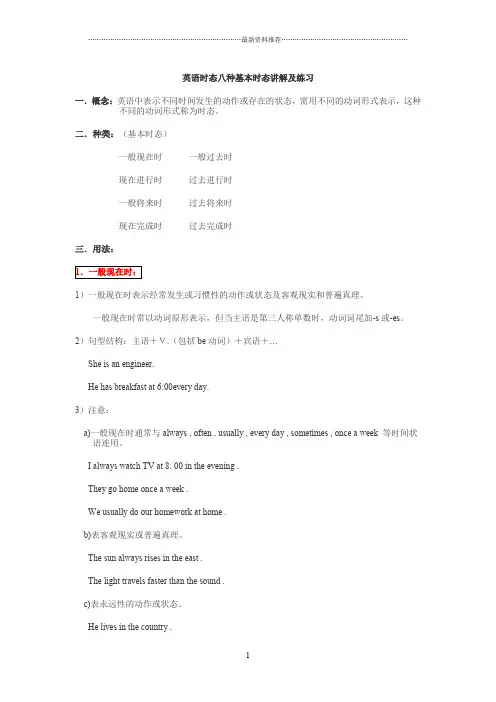
英语时态八种基本时态讲解及练习一.概念:英语中表示不同时间发生的动作或存在的状态,需用不同的动词形式表示,这种不同的动词形式称为时态。
二.种类:(基本时态)一般现在时一般过去时现在进行时过去进行时一般将来时过去将来时现在完成时过去完成时三.用法:1)一般现在时表示经常发生或习惯性的动作或状态及客观现实和普遍真理。
一般现在时常以动词原形表示,但当主语是第三人称单数时,动词词尾加-s或-es。
2)句型结构:主语+V.(包括be动词)+宾语+…She is an engineer.He has breakfast at 6:00every day.3)注意:a)一般现在时通常与always , often , usually , every day , sometimes , once a week等时间状语连用。
I always watch TV at 8: 00 in the evening .They go home once a week .We usually do our homework at home .b)表客观现实或普遍真理。
The sun always rises in the east .The light travels faster than the sound .c)表永远性的动作或状态。
He lives in the country .4)第三人称单数变化形式。
a)一般情况动词在词尾加-s .come---comes speak---speaks work---works live---lives b)以o, s, x, ch, sh结尾的单词在词后加-es.do---does go---goes finish---finishes brush---brushes fix---fixes pass---passes watch---watchesc)以“辅音字母+y”结尾的单词变y为i加-es.Study---studies carry-carries cry---criesd)以“元音字母+y”结尾的单词直接加-s.play---plays stay---stays例句:我们每天晚上九点做作业。
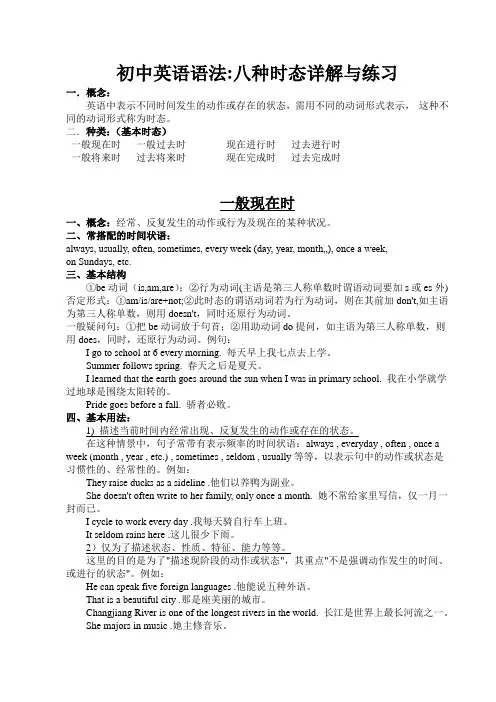
初中英语语法:八种时态详解与练习一.概念:英语中表示不同时间发生的动作或存在的状态,需用不同的动词形式表示,这种不同的动词形式称为时态。
二.种类:(基本时态)一般现在时一般过去时现在进行时过去进行时一般将来时过去将来时现在完成时过去完成时一般现在时一、概念:经常、反复发生的动作或行为及现在的某种状况。
二、常搭配的时间状语:always, usually, often, sometimes, every week (day, year, month…), once a week,on Sundays, etc.三、基本结构①be动词(is,am,are);②行为动词(主语是第三人称单数时谓语动词要加s或es外) 否定形式:①am/is/are+not;②此时态的谓语动词若为行为动词,则在其前加don't,如主语为第三人称单数,则用doesn't,同时还原行为动词。
一般疑问句:①把be动词放于句首;②用助动词do提问,如主语为第三人称单数,则用does,同时,还原行为动词。
例句:I go to school at 6 every morning. 每天早上我七点去上学。
Summer follows spring. 春天之后是夏天。
I learned that the earth goes around the sun when I was in primary school. 我在小学就学过地球是围绕太阳转的。
Pride goes before a fall. 骄者必败。
四、基本用法:1) 描述当前时间内经常出现、反复发生的动作或存在的状态。
在这种情景中,句子常带有表示频率的时间状语:always , everyday , often , once a week (month , year , etc.) , sometimes , seldom , usually等等,以表示句中的动作或状态是习惯性的、经常性的。
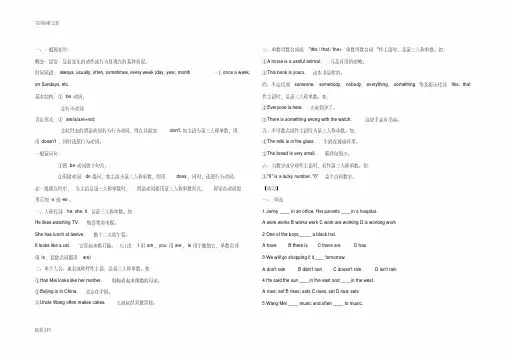
一、一般现在时:概念:经常、反复发生的动作或行为及现在的某种状况。
时间状语:always, usually, often, sometimes, every week (day, year, month…), once a week, on Sundays, etc.基本结构:①be动词;②行为动词否定形式:①am/is/are+not;②此时态的谓语动词若为行为动词,则在其前加don't,如主语为第三人称单数,则用doesn't,同时还原行为动词。
一般疑问句:①把be动词放于句首;②用助动词do提问,如主语为第三人称单数,则用does,同时,还原行为动词。
在一般现在时中,当主语是第三人称单数时,谓语动词要用第三人称单数形式,即常在动词原形后加-s或-es。
一、人称代词he, she, it是第三人称单数。
如:He likes watching TV. 他喜欢看电视。
She has lunch at twelve. 她十二点吃午餐。
It looks like a cat. 它看起来像只猫。
(口诀:I用am,you用are,is用于她他它,单数名词用is,复数名词都用are)二、单个人名、地名或称呼作主语;是第三人称单数。
如:①Han Mei looks like her mother. 韩梅看起来像她的母亲。
②Beijing is in China. 北京在中国。
③Uncle Wang often makes cakes. 王叔叔经常做蛋糕。
三、单数可数名词或"this / that / the+单数可数名词"作主语时,是第三人称单数。
如:①A horse is a useful animal. 马是有用的动物。
②This book is yours. 这本书是你的。
四、不定代词someone, somebody, nobody, everything, something等及指示代词this, that 作主语时,是第三人称单数。
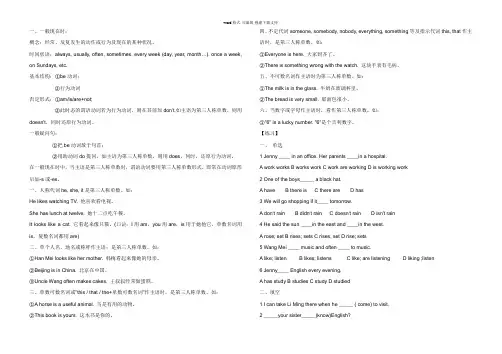
一、一般现在时:概念:经常、反复发生的动作或行为及现在的某种状况。
时间状语:always, usually, often, sometimes, every week (day, year, month…), once a week, on Sundays, etc.基本结构:①be动词;②行为动词否定形式:①am/is/are+not;②此时态的谓语动词若为行为动词,则在其前加don't,如主语为第三人称单数,则用doesn't,同时还原行为动词。
一般疑问句:①把be动词放于句首;②用助动词do提问,如主语为第三人称单数,则用does,同时,还原行为动词。
在一般现在时中,当主语是第三人称单数时,谓语动词要用第三人称单数形式,即常在动词原形后加-s或-es。
一、人称代词he, she, it是第三人称单数。
如:He likes watching TV. 他喜欢看电视。
She has lunch at twelve. 她十二点吃午餐。
It looks like a cat. 它看起来像只猫。
(口诀:I用am,you用are,is用于她他它,单数名词用is,复数名词都用are)二、单个人名、地名或称呼作主语;是第三人称单数。
如:①Han Mei looks like her mother. 韩梅看起来像她的母亲。
②Beijing is in China. 北京在中国。
③Uncle Wang often makes cakes. 王叔叔经常做蛋糕。
三、单数可数名词或"this / that / the+单数可数名词"作主语时,是第三人称单数。
如:①A horse is a useful animal. 马是有用的动物。
②This book is yours. 这本书是你的。
四、不定代词someone, somebody, nobody, everything, something等及指示代词this, that作主语时,是第三人称单数。
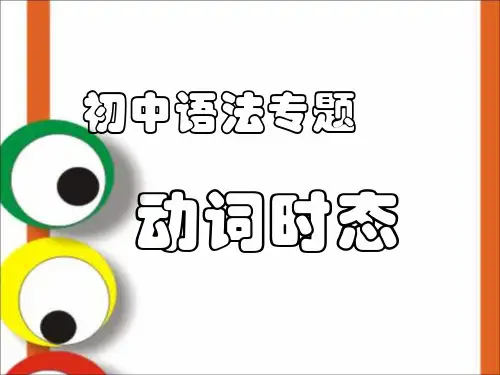
__________________________________________________ 收集于网络,如有侵权请联系管理员删除 初中英语时态讲解
一、一般现在时:概念:经常、反复发生的动作或行为及现在的某种状况。 时间状语:
always, usually, often, sometimes, every week (day, year, month…), once a week, on Sundays等 基本结构:①be动词; ②行为动词 否定形式:①am/is/are+not; ②此时态的谓语动词若为行为动词,则在其前加don't,如主语为第三人称单数,则用doesn't,同时还原行为动词。 一般疑问句: ①把be动词放于句首; ②用助动词do提问,如主语为第三人称单数,则用does,同时,还原行为动词。 在一般现在时中,当主语是第三人称单数时,谓语动词要用第三人称单数形式,即常在动词原形后加-s或-es。 一、 【人称代词he, she, it是第三人称单数】。如: He likes watching TV. 他喜欢看电视。 She has lunch at twelve. 她十二点吃午餐。It looks like a cat. 它看起来像只猫。 (口诀:I用am,you用are,is用于她他它,单数名词用is,复数名词都用are) 二、 【单个人名、地名或称呼作主语;是第三人称单数】。如: ①Han Mei looks like her mother. 韩梅看起来像她的母亲。 ②Beijing is in China. 北京在中国。 ③Uncle Wang often makes cakes. 王叔叔经常做蛋糕。 三、 【单数可数名词或"this / that / the+单数可数名词"作主语时,是第三人称单数】。如: ①A horse is a useful animal. 马是有用的动物。 ②This book is yours. 这本书是你的。 四、 【不定代词someone, somebody, nobody, everything, something等及指示代词this, that作主语时,是第三人称单数】。 如: ①Everyone is here. 大家到齐了。 ②There is something wrong with the watch. 这块手表有毛病。 五、 【不可数名词作主语时为第三人称单数】。如: ①The milk is in the glass. 牛奶在玻璃杯里。 ②The bread is very small. 那面包很小。 六、 【当数字或字母作主语时,看作第三人称单数】。如: ①"6" is a lucky number. "6"是个吉利数字。 【练习】 一、 单选 1. Jenny ____ in an office. Her parents ____in a hospital. A work works B works work C work are working D is working work 2 One of the boys_____ a black hat. A have B there is C there are D has 3 We will go shopping if it____ tomorrow. A don't rain B didn't rain C doesn't rain D isn't rain 4 He said the sun ____in the east and ____in the west. A rose; set B rises; sets C rises, set D rise; sets 5 Wang Mei ____ music and often ____ to music. A like; listen B likes; listens C like; are listening D liking listen 6 Jenny____ English every evening. A has study B studies C study D studied 二、填空 1.Her home____ _____ ______(远离 )her school. 2.Who_____(想要 )to go swimming? 3. I can take Li Ming there when he _____ ( come) to visit. 4.______she_____(do) the housework every day?5 The pot_____(not look) like yours very much. 6 Where _____you____(have)lunch every day? 7 Jenny and Danny usually______(play) games in the afternoon . 8_____your sister_____(know)English? 二、一般过去时:概念:过去某个时间里发生的动作或状态;过去习惯性、经常性的动作、行为。
时间状语:ago, yesterday, the day before yesterday,last week(year, night, month…), in 1989, just now, at the age of 5, one day, long long ago, once upon a time, etc. 一般过去时的结构(可分三类不同的结构) 1.Be动词的一般过去时 在没有实义动词的句子中使用be动词, am is 的过去式为was; are的过去式为were 肯定句式:主语 + be(was , were) + 其它. 否定句式:主语 + be(was , were) + not + 其它. 一般疑问句:Be(was , were) + 主语 + 其它? 注:在这种构成中,be动词有人称和数的变化,即要根据主语选用was / were。Be动词分为单数和复数,was是表示单数,were是表示复数。 2.实义动词的一般过去时态 肯定句要使用动词的过去式,否定句和疑问句要使用助动词do和 does 的过去式 did. 肯定句式:主语 + 动词(过去式)+ 其它 否定句式:主语 + didn’t + 动词(原形)+ 其它 【did not = didn’t】 一般疑问句:Did + 主语+ 动词(原形)+ 其它【do , does的过去时均为did】? 注:1. did和didn’t是构成一般过去时的助动词,其特点是要在其后跟动词的原形。 2. 实意动词do的一般过去时 I do my homework every day.(用yesterday改写句子) I did my homework yesterday. I didn’t do my homework yesterday.(否定句) Did you do your homework yesterday?Yes ,I did. /No, I didn’t.(一般疑问句) 3. 情态动词的一般过去时态 含有情态动词的一般过去时与含有Be动词的一般过去时,是十分相似,请注意观察。 肯定句式:主语 + 情态动词 + 其它 否定句式:主语 + 情态动词 + not + 其它. 一般疑问句:情态动词 + 主语 + 其它? 注:情态动词的过去式:can→could , may→might , must→must ,will-would,should-should。 __________________________________________________ 收集于网络,如有侵权请联系管理员删除 4.特殊疑问句式: 特殊疑问词+be过去式+主语+其他?
特殊疑问词+情态助动词过去式+主语+动词原形+其他? 特殊疑问词+do/does过去式+主语+动词原形+其他? What was your former name? 你以前叫什么名字? Why was he late for school last Monday? 上星期一他为什么迟到? What could she do twenty years ago? 20年前她能做什么? 规则动词的过去式 1..一般情况下,在动词原形后面加-ed。 look→looked play→played start→started visit→visited pull-pulled, cook-cooked 2.以不发音e结尾的动词,在词尾直接加-d。 live→lived use→used taste-tasted 3.以―辅音字母+ y‖结尾的动词,先将 y 改为i ,再加 –ed。 study→studied try→tried fly→flied 4.以重读闭音节(即辅音+元音+辅音)或r音节结尾,末尾只有一个辅音字母的动词,要先双写这个辅音字母后,再加 –ed。 stop→stopped plan→planned stop-stopped prefer→preferred 5.不规则动词的过去式需特殊记忆。 如:am(is)-was, are-were(是), become _became (成为) go-went(走) 基本用法 ① 表示过去某个特定时间发生的动作或存在的状态。 He suddenly fell ill last night. 他昨晚突然病倒了。 ②表示过去的习惯性或经常发生的动作 She went to the cinema once a month when she was at walked by the riverside. 我在乡下时经常在河边散步。 ③叙述过去连续发生的一件件事 She got up early, fetched water, cleaned the room and then went out for a walk. 她早早起床,提水,打扫房间然后出去散步。 【练习】 一、请用正确动词形式填空 1. He (live) in Wuxi two years ago. 2. The cat (eat) a bird last night. 3. We (have) a party last Halloween.4. Nancy (pick) up oranges on the farm last week. 5. I (make) a model ship with Mike yesterday. 6. They (play) chess in the classroom last PE lesson. 7. My mother (cook) a nice food last Spring Festival. 8. The girls (dance) at the party last night. 9. I (watch) a cartoon on Saturday last week. 10. ______ you _______ (visit) your relatives last Spring Festival? 11. ______ he _______ (fly) a kite on Sunday? Yes, he ______. 12. Gao Shan _______ (put) up the picture last night. 13. I ____________ (sweep) the floor yesterday. 14. What ______ she _______ (find) in the garden last morning? 15. Her father _______ (read) a newspaper last night. 16. Mike _________________(not go) to bed until 12 o‘clock last night. 17. I listened but ___________ (hear) nothing. 18. How many people ________ (be) there in your class last term? 二、按要求变换句型。 1. Frank read an interesting book about history. (一般疑问句) _______ Frank _______ an interesting book about history? 2. He cleaned his room just now.. (划线提问) What________ he _______? 3. Thomas spent RMB 10 on this book. (否定句) Thomas _______ _______ RMB 10 on this book. 4. My family went to the beach last week. (划线提问) ________ ________ ________ family _______ last week? 1. I _________ (have) an exciting party last weekend. 2. She _________(not visit) her aunt last weekend. 3. _________ she _________(practice) her guitar yesterday? No, she _________. 4. What ________ Tom ________ (do) on Saturday evening? He ________(watch) TV and __________(read) an interesting book. 5. They all _________(go) to the mountains yesterday morning. She ________ (stay) at home and _________(do) some cleaning. 6. When ________ you _________(write) this song? I __________(write) it last year. 7. My friend, Carol, ________(study) for the math test and ________(practice) English last night. 8. ________ Mr. Li __________(do) the project on Monday morning? Yes, he _________. 9. How _________(be) Jim's weekend? It _________(be not) bad. 10. ________ (be) your mother a sales assistant last year? No. she __________. 三、现在进行时: 概念:表示现阶段或说话时正在进行的动作及行为。